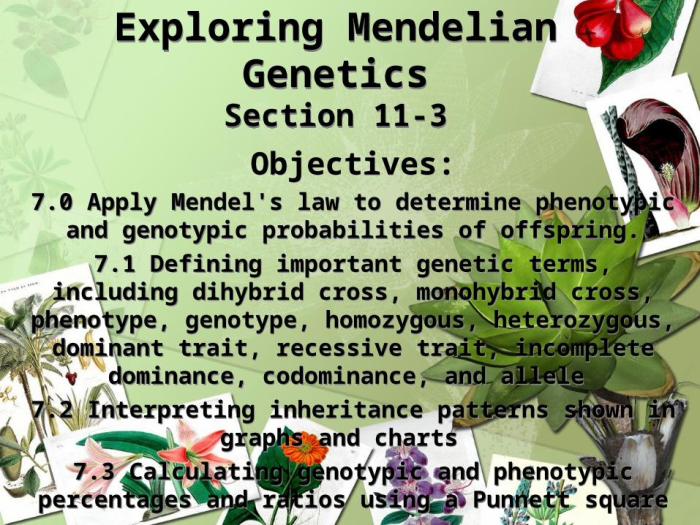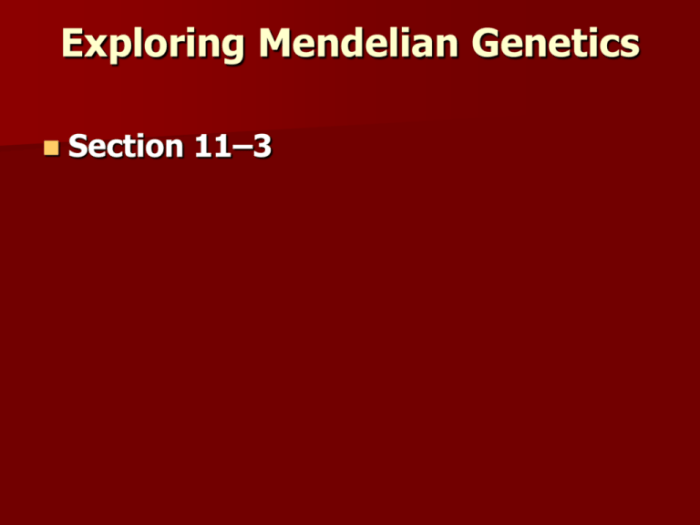Section 11-3 exploring mendelian genetics – Embarking on a journey through Section 11-3: Exploring Mendelian Genetics, we delve into the profound legacy of Gregor Mendel’s groundbreaking experiments and unravel the fundamental principles that govern the transmission of hereditary traits. This captivating exploration promises to illuminate the intricate mechanisms that shape the genetic tapestry of life.
From the meticulous observations of pea plants to the elucidation of fundamental laws, Mendel’s pioneering work laid the cornerstone for our understanding of inheritance. We will delve into the intricacies of his Law of Segregation and Law of Independent Assortment, providing a comprehensive framework for understanding the patterns of genetic inheritance.
1. Introduction to Mendelian Genetics

Mendelian genetics, named after Gregor Mendel, is the foundation of modern genetics. Mendel’s experiments with pea plants in the mid-1800s revolutionized our understanding of inheritance and established the basic principles of genetic inheritance.
Mendel’s work provided a framework for understanding how traits are passed from parents to offspring. His experiments revealed the concept of discrete units of inheritance, later known as genes, which are responsible for the inheritance of specific characteristics.
Mendel’s Laws, Section 11-3 exploring mendelian genetics
Mendel’s laws of inheritance are fundamental principles that govern the transmission of genetic traits. These laws include:
- Mendel’s Law of Segregation:Alleles for a particular gene segregate during gamete formation, ensuring that each gamete carries only one allele for each gene.
- Mendel’s Law of Independent Assortment:Alleles for different genes assort independently of each other during gamete formation, meaning that the inheritance of one gene does not influence the inheritance of another.
Punnett Squares
Punnett squares are a valuable tool for predicting the probability of inheriting specific traits. These squares provide a visual representation of the possible combinations of alleles that can occur in offspring.
To use a Punnett square, the alleles carried by the parents are listed along the sides of the square. The possible offspring genotypes are then determined by combining the alleles from each parent.
Extensions of Mendelian Genetics
Mendel’s principles of inheritance have been extended to explain more complex genetic phenomena, including:
- Incomplete Dominance:In incomplete dominance, neither allele is completely dominant over the other, resulting in an intermediate phenotype.
- Codominance:In codominance, both alleles are expressed in the phenotype, resulting in a distinct phenotype for each allele.
- Polygenic Inheritance:Many traits are influenced by multiple genes, resulting in a continuous variation in the phenotype.
Pedigree Analysis
Pedigree analysis is a valuable tool for tracing the inheritance of traits within a family. Pedigrees are diagrams that represent the relationships between family members and indicate the presence or absence of specific traits.
Pedigrees can be used to identify patterns of inheritance, determine the mode of inheritance, and estimate the risk of inheriting a particular trait.
General Inquiries: Section 11-3 Exploring Mendelian Genetics
What is the significance of Gregor Mendel’s experiments?
Mendel’s experiments with pea plants established the fundamental principles of inheritance, providing a foundation for modern genetics.
Explain Mendel’s Law of Segregation.
Mendel’s Law of Segregation states that during gamete formation, the alleles for each gene separate and segregate randomly, ensuring that each gamete carries only one allele for each gene.
How do Punnett squares help predict the probability of inheriting specific traits?
Punnett squares are a tool used to predict the probability of inheriting specific traits by visually representing the possible combinations of alleles that can be passed on from parents to offspring.


